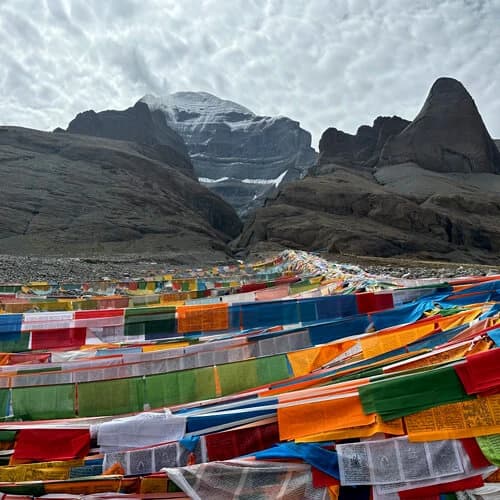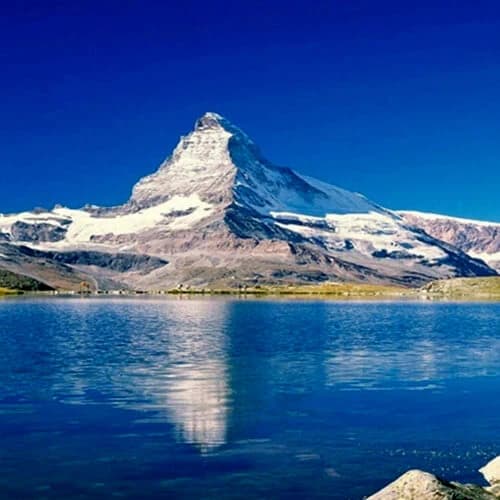The Mounta Kailash Mansarovar Tour is one of the most renowned pilgrimages in the world, ideal for spiritual enthusiasts and adventure lovers. The main highlights of this exceptional tour are the majestic Mount Kailash and the divine Mansarovar Lake. Mount Kailash is considered the home of Lord Shiva in Hinduism and a spiritual center in Buddhism, Jainism, and Bon. Similarly, Mansarovar is the highest freshwater Lake in the world and is believed to cleanse sins and bring good fortune. Besides these holy places, this exciting yatra offers the breathtaking beauty of nature traversing rugged terrain, high-altitude passes, and beautiful monasteries. A trip to the Kailash region is the perfect test of physical and mental endurance, where you can explore diverse cultures, traditions, and rituals. The tour can be challenging for many trekkers due to the region's high altitudes, unpredictable climate, and remoteness. So, you must be well-prepared before heading on this exciting journey, especially regarding food and drinks, as you need energy and hydration to overcome the challenges along the trail. This blog explores the various food and drink options with essential tips and cultural insights of the Kailash region.
Food and Drinks in Kailash Mansarovar Tour
Why are Food and Drinks Essential on the Tour?
Food and drink are essential to staying energized and healthy throughout the Kailash Mansarovar Tour. The region's high altitude and remoteness demand physical and mental endurance, so your body needs nourishment to overcome the challenges along the trail. Therefore, it is necessary to understand the availability of various food and drinks in the Kailash region. Pasta, rice, noodles, packed soups, roti, etc, are served by the teahouses to the pilgrims and tourists. Other than this, you can enjoy fresh fruits and vegetables at reasonable rates from the local market. Healthy food and adequate hydration also help to avoid common issues like altitude sickness and other health hazards, enhancing your overall trekking experience. Additionally, knowing local delicacies allows you to immerse in the region's culture and connect with local communities. So, you must consult your tour operator about your preferred food and drinks throughout the trek and choose the Kailash Mansarovar Tour package accordingly.
Food in the Kailash Mansarovar Region
Kailash Mansarovar Tour takes about fifteen or more days to complete, depending on your chosen package. During such long trips in high-altitude regions, one of the most common concerns of trekkers and pilgrims is the availability of healthy food and drinks. However, this spiritual tour offers you multiple options for food and beverages, depending on the location. You can enjoy various traditional Tibetian cuisines and vegetarian and vegan meals for devotees. Different foods and drinks in the Kailash region are discussed below.
Tibetan Cuisines
Local food in the Kailash region is highly influenced by Tibetan culture. Tibetan cuisines are simple and tasty, providing warmth and the high energy required to overcome the challenges of cold temperatures and high altitude. Some famous Tibetan foods that are available during the tour are as follows.
- Momo: Dumplings filled with meat or vegetables and served with a spicy dipping sauce.
- Sha Phaley: Fried bread stuffed with meat or vegetables.
- Thukpa: Noodle soup made with meat or vegetables.
- Thenthuk: A variation of thukpa, which includes hand-pulled noodles.
- Tsampa: A traditional Tibetan food made from roasted barley flour.
Vegetarian and Vegan Options
Vegetarian and vegan foods are available throughout the tour, especially in pilgrimage spots, monasteries, and local lodges. As the Kailash Mansarovar Tour holds spiritual and religious values of Buddhism, pilgrims follow vegetarian diets to protect animal lives. Some renowned vegetarian dishes along the trail are rice, vegetable curry, lentil soup, momo, and thukpa.
Drinks in the Kailash Mansarovar Region
Kailash Mansarovar Tour takes you to the high-altitude remote regions of Tibet, where the weather can be unpredictable, with cold surrounding temperatures. Such adverse conditions pose a potential risk of altitude sickness. You must keep your body hydrated and healthy to prevent such risks and illnesses. There are multiple options for beverages throughout the trip, ranging from traditional Tibetan drinks to safe drinking water, which are described below briefly.
Traditional Tibetan Beverages
Warm drinks are an essential part of Tibetan culture and lifestyle, as they allow people to face the cold temperatures of the Kailash Mansarovar region. The most famous drink in the area is Po Cha, a traditional Butter Tea made from milk, salt, tea leaves, water, and salt. It is full of nutrients and keeps you warm in cold conditions. Apart from that, Chang is another renowned drink in the Kailash region. It is an alcoholic drink made from barley, millet, or rice and consumed at festivals and special occasions. Enjoy these beverages during the trek, but we recommend avoiding alcoholic drinks.
Safe Drinking Water
Hydration is crucial to preventing altitude sickness in high-altitude regions with low air pressure and oxygen levels. However, to avoid various diseases, it is essential to drink 3-4 liters of clean water away from bacteria and pathogens. Water bottles are available at multiple stops along the trail but can be expensive. We recommend you carry purification tablets or a portable water filter for safe drinking water from local sources, such as streams and taps, which also help to keep the surroundings clean from plastic waste.
Food and Drinks Cost
Food and drink generally account for around ten percent of trek expenses. That’s why allocating a significant budget for food and beverages is essential before heading on the Kailash Mansarovar Tour. The cost of such dietary items depends on the location's remoteness and altitude. Due to challenges in the transportation of goods in the Kailash region, food and drinks can be more expensive than in other parts of Tibet or Nepal. You can enjoy foods like Dal Bhat (rice and lentils), Momo, and Chowmein in Kathmandu at $3 to $5. Apart from these famous foods, you also have other options, such as Thakali set meals, Newari cuisine, and Continental or Indian dishes at $7 to $15, depending on the restaurant. However, as you move to the Tibet region and finally to Kailash Mansarovar, the food and drink costs gradually increase. During the trek, traditional Tibetan dishes like Momo, Thukpa, and Sha Phaley cost around $5 to $10. Similarly, vegetarian and vegan options are usually cheaper as meals at monasteries are more affordable and offered as a part of your stay. On the other hand, beverages like traditional Butter Tea (Po Cha) can cost around $2 to $5 per cup, whereas bottled water is priced at around $1 to $3 per liter. However, as you ascend to the higher altitudes of the Kailash region, these prices can rise due to transportation challenges. So, we recommend you bring some extra money to cover any expenses caused by unforeseen circumstances. Keeping all these things in check, you can budget around $20 to $30 per day for food and drinks for a comfortable and enriching experience.
Tips for Healthy Food and Drinks
- Take carbohydrate-rich meals to keep you energized throughout the day.
- Choose fresh and well-cooked foods, as heat kills most bacteria, causing various diseases.
- Avoid contaminated, raw, and fatty foods that are hard to digest.
- Drink at least 3-4 liters of water daily, as staying hydrated helps to reduce the risk of altitude sickness.
- Use purification tablets or water filters to purify or drink boiled water.
- Stay away from alcohol, narcotics, caffeine, and similar substances that dehydrate your body.
- Carry your own eating utensils and hand sanitizer, as soap and water might be lacking in some remote areas.
- Bring the necessary medications if you have any food allergies.
- Consult your tour operator about your dietary preferences before the trek and plan the tour package accordingly.
- Carry electrolytes, nutritional supplements, and snacks like dry fruits, protein bars, and chocolate for quick energy during the trek.
- Keep the environment clean, dispose of waste properly, and avoid non-biodegradable substances like plastics.
Cultural Etiquette Around Food and Drinks
Learning about the local dietary customs and traditions is essential if you visit the Kailash Mansarovar region. Some local customs while dining along the route include sharing food, eating with hands, and other religious practices. Meals in monasteries are often shared, and it’s customary to accept what is offered there. On the other hand, most local people in this area eat with their hands and pray to god before eating, so respect these local customs and try to follow them. Besides these customs, food in the Kailash region is highly influenced by religious practices. Most people in Tibet follow Buddhism, offering food to deities and avoiding meat on specific days. Understanding these customs and cultures allows you to connect with the local communities, enhancing your overall pilgrimage and trekking experience. So, be open-minded, express gratitude to locals, preserve the environment, and experience the spiritual journey of Kailash Mansarovar.
Why Choose Outfitter Nepal?
Outfitter Nepal is one of the most renowned tour operators in Nepal. Our company will provide all the necessary support before embarking on the spiritual journey to Kailash Mansarovar. With over 15 years of experience organizing trips to this sacred region, we offer expert guides with proper knowledge of the region’s diverse landscapes, local traditions, religious values, and challenges along the trail. We will offer customizable itineraries based on your needs and preferences, including food, drinks, and accomodation. Our company prioritizes safety with proper acclimatization, medical support, and reliable logistics, allowing you to focus on the spiritual aspects of your pilgrimage and the adventure of high-altitude trekking. Our commitment to cultural immersion also ensures you connect deeply with the local people and customs, giving you an unforgettable experience for a lifetime. So, get your backpack ready and lace your trekking bots to conquer the spiritual hub of Tibet with Outfitter Nepal.
Some Most Popular Tours
- Tibet Everest Base Camp Motorbike Tour
- Kailash Motorbike Tour - 11 Days
- Mount Kailash Yatra for Indian People
- Kathmandu Lhasa Overland Tour - 8 Days
- Kailash Mansarovar Luxury Tour - 15 Days
- Short Tibet Lhasa Tour - 4 Days
- Kailash Mansarovar Tour - 10 Days
- Mount Kailash Charan Sparsh Tour - 15 Days
- Tibet Everest Base Camp Tour - 8 Days
- Nepal Tibet Tour - 9 Days
- Saga Dawa Festival Tour - 16 Days



